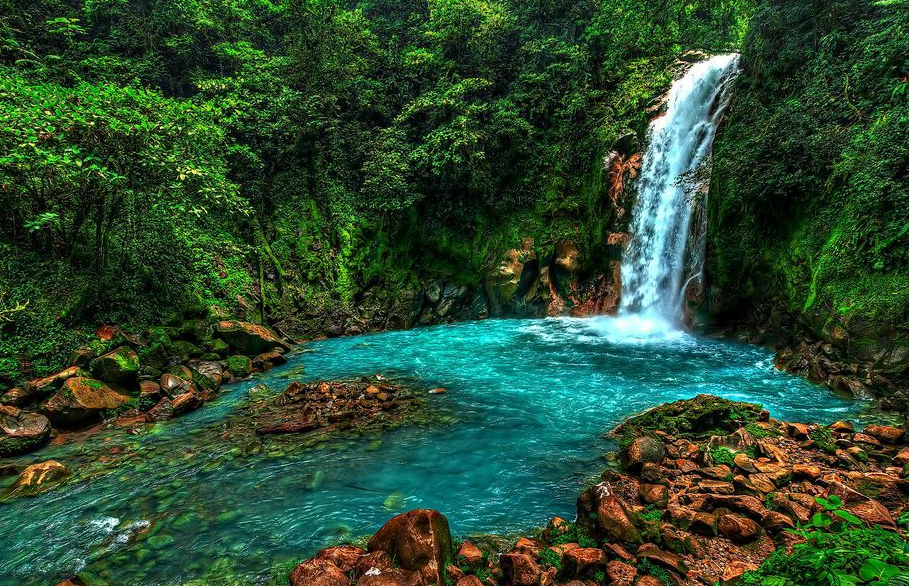Rio Celeste, a wonder of nature to visit in Costa Rica

The Celeste River of Costa Rica is located in the canton of Guatuso, specifically in the province of Alajuela and in the well-known Tenorio Volcano National Park, in the Arenal and Tempisque conservation area. The river is formed by the confluence of others, the Buena Vista and the Quebrada Agria, both running through the slopes of the volcano itself.

What is special about the Rio Celeste?
Well, the most remarkable thing and for what it is recognized worldwide is the incredible optical effect that it offers to all those who are lucky enough to visit it.

Although it may seem incredible, nature always has something else to surprise us with, and an example of this is this well-known national park.
There is even a legend around this river: when God cleaned his brushes after finishing painting the sky, this incredible landscape was created in a river of light blue and turquoise tones located in Costa Rica.
There are 14 km of intense blue route that are also surrounded by a large number of tourist attractions in the surroundings, which gives it an even more special air: forests, lagoons, dyers and other places later we will comment in more depth .
Origin of the phenomenon

Scientists spent many years studying the phenomenon until they realized why the river was stained with this peculiar color. But it took until 2013 to get this answer.
Researchers from the universities of Costa Rica and the National University were taking different samples of the water that flowed through the river, both from Celeste itself and from any of its tributaries (the Quebrada Agria River and the Buena Vista River), and thus it was possible to solve the enigma after so many years.

The mysterious blue color is produced by the composition of the river water itself. When the colloidal silica is suspended in the water particles, it manages to reflect the light that hits and returns an image of a blue river in Costa Rica, fooling the human eye.
What to see in the Tenorio Volcano National Park
The Tenorio Volcano National Park is one of the country’s richest protected wild areas in biodiversity, which is why different environmental, conservation and, above all, ecotourism activities are regularly carried out there.

In addition to the spectacular visual effect that we have just described on the river, the truth is that the area has many more tourist attractions to offer.
The Tenorio volcano

This volcano is the one that gives its name to the park itself, and it has a height of 1916 meters. It is located in the Guanacaste mountain range. It is made up of four volcanic blocks and has two twin craters, all of them inactive since at least 1864, but which can be seen throughout the route through the national park itself thanks to its high altitude.
Waterfalls

There are different waterfalls that also retain the intense blue coloration that we have mentioned before. Some have a considerable height, falling up to 30 meters. The depth in these areas can be up to 17 meters!
Los Hervideros or Borbollones

Los Hervideros are a place that contains hot springs where the temperature can reach up to 94 degrees, so bathing in the area is not possible.
The blue Lagoon
In the course of the river itself, there are some extensions that form true lakes or lagoons, such as, in this case, the blue lagoon, where colloidal silica accumulates especially because the passage of water occurs much more slowly.

In this way, the coloration in this lagoon is still a more intense blue, visible especially on sunny days.
The dyeers
In the course of the river a very curious phenomenon occurs that leaves all those who are lucky enough to witness it impressed.

In this place, the colloidal silica begins to settle at the bottom of the water, instead of being dispersed by it, so at this time there is a change from the blue coloration to a more transparent coloration, or even brown if drags dissolved earth in it.
Orchids and felines
The flora is typical of a cloud forest and a pluvial forest, highlighting a great diversity of heliconia, ferns, palms, and orchids.
The most characteristic trees are the sapote, the pilón, the jícaro giving and the aguatillo.
Also, if you are lucky enough, you can see peccary, monkeys, tolomucos, guatusas, Matabuey snakes, velvets and mouths.
Costa Rica is a true natural paradise, something that you can see for yourself by visiting the Tenorio Volcano National Park and its wonderful river with that particular blue color. There are many who have already been able to enjoy this natural wonder.